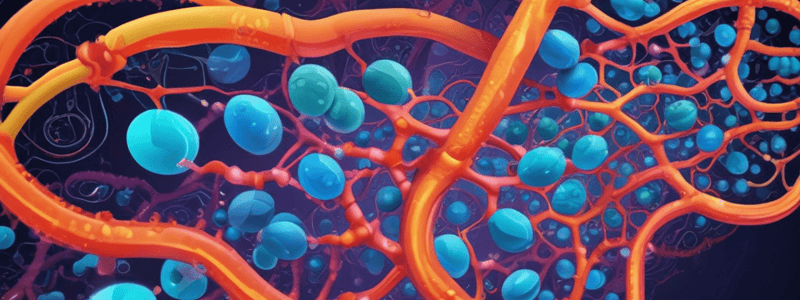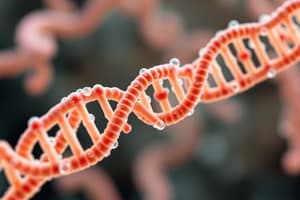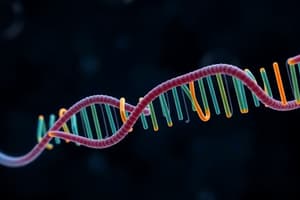Podcast
Questions and Answers
What is the primary function of spliceosomes in pre-mRNA processing?
What is the primary function of spliceosomes in pre-mRNA processing?
- To transcribe DNA into pre-mRNA
- To translate pre-mRNA into protein
- To degrade faulty mRNA molecules
- To remove introns and join exons to form mature mRNA (correct)
What is the outcome of the two-step process of splicing in spliceosomes?
What is the outcome of the two-step process of splicing in spliceosomes?
- Cleavage of the 5' splice site and release of the exon
- Formation of a lariat structure and release of the intron (correct)
- Cleavage of the 3' splice site and retention of the exon
- Formation of a lariat structure and retention of the intron
How do spliceosomes regulate gene expression at the post-transcriptional level?
How do spliceosomes regulate gene expression at the post-transcriptional level?
- By translating mRNA into protein
- By controlling transcription initiation
- By controlling the inclusion or exclusion of exons (correct)
- By degrading mRNA molecules
What is the result of alternative splicing mediated by spliceosomes?
What is the result of alternative splicing mediated by spliceosomes?
What is the role of small nuclear RNAs (snRNAs) in spliceosome function?
What is the role of small nuclear RNAs (snRNAs) in spliceosome function?
What is the outcome of differential splicing mediated by spliceosomes?
What is the outcome of differential splicing mediated by spliceosomes?
What is the reason for the U3 being classified as a snRNA?
What is the reason for the U3 being classified as a snRNA?
What is the characteristic of the U7 that distinguishes it from the other U-snRNAs?
What is the characteristic of the U7 that distinguishes it from the other U-snRNAs?
Why do the 7 U-snRNAs have the names they do?
Why do the 7 U-snRNAs have the names they do?
What is the role of proteins in the spliceosome?
What is the role of proteins in the spliceosome?
What is the characteristic of the U-snRNAs in the spliceosome?
What is the characteristic of the U-snRNAs in the spliceosome?
What is the main role of U2 snRNA in the splicing process?
What is the main role of U2 snRNA in the splicing process?
Why do some introns have imperfect consensus sequences?
Why do some introns have imperfect consensus sequences?
What is the role of U2AF proteins in the splicing process?
What is the role of U2AF proteins in the splicing process?
How does the spliceosome recognize the 5' and 3' ends of the intron?
How does the spliceosome recognize the 5' and 3' ends of the intron?
What is the function of the U11, U12, and other minor snRNAs?
What is the function of the U11, U12, and other minor snRNAs?
What is the unique feature of the 2’OH in the special conformation of the spliceosome?
What is the unique feature of the 2’OH in the special conformation of the spliceosome?
What is the approximate size of the spliceosome machinery?
What is the approximate size of the spliceosome machinery?
Which snRNA is responsible for recognizing the 5' splice site?
Which snRNA is responsible for recognizing the 5' splice site?
What is the role of U6 in the spliceosome?
What is the role of U6 in the spliceosome?
What is the outcome of the interaction between U2 and U6 in the spliceosome?
What is the outcome of the interaction between U2 and U6 in the spliceosome?
What is the location where the spliceosome 'waits' for the RNA polymerase to start transcribing introns?
What is the location where the spliceosome 'waits' for the RNA polymerase to start transcribing introns?
What is the fate of introns that have been spliced out of the primary transcript?
What is the fate of introns that have been spliced out of the primary transcript?
What is the function of the corpúsculos de Cajal (Cajal bodies) in the nucleus?
What is the function of the corpúsculos de Cajal (Cajal bodies) in the nucleus?
What is the significance of the finding that introns are mostly found in the nucleus?
What is the significance of the finding that introns are mostly found in the nucleus?
What is the function of the complex E in the formation of the spliceosome?
What is the function of the complex E in the formation of the spliceosome?
What is the purpose of marking introns with different fluorophores in the experiment described?
What is the purpose of marking introns with different fluorophores in the experiment described?
What is the role of U6 in the formation of the complex B1?
What is the role of U6 in the formation of the complex B1?
What happens to U1 during the formation of the complex B2?
What happens to U1 during the formation of the complex B2?
What is the function of the complex C1?
What is the function of the complex C1?
What is the result of the interaction between U6 and U2 during the formation of the complex C1?
What is the result of the interaction between U6 and U2 during the formation of the complex C1?
Flashcards are hidden until you start studying
Study Notes
Spliceosomes
Splicing Mechanisms
- Intron removal: Spliceosomes remove introns (non-coding regions) from pre-mRNA, joining exons (coding regions) to form mature mRNA.
- Two-step process:
- Branch point formation: A lariat structure is formed between the branch point and the 5' splice site.
- Splice site cleavage: The 5' splice site is cleaved, and the intron is released.
RNA Processing
- Pre-mRNA splicing: Spliceosomes play a crucial role in pre-mRNA splicing, which occurs in the nucleus.
- Alternative splicing: Spliceosomes can generate different mRNA isoforms from a single gene by selecting different splice sites.
- RNA-RNA interactions: Spliceosomes mediate interactions between pre-mRNA and small nuclear RNAs (snRNAs) to facilitate splicing.
Post-transcriptional Regulation
- Regulation of gene expression: Spliceosomes can regulate gene expression by controlling the inclusion or exclusion of exons, affecting protein function.
- Tissue-specific splicing: Spliceosomes can generate tissue-specific mRNA isoforms, contributing to cellular diversity.
Gene Expression
- Spliceosome-mediated gene regulation: Spliceosomes can regulate gene expression by controlling the production of functional mRNA.
- Differential splicing: Spliceosomes can generate different mRNA isoforms in response to environmental cues or developmental signals.
Spliceosome Structure
- Small nuclear ribonucleoproteins (snRNPs): Spliceosomes consist of snRNPs, which are complexes of snRNAs and proteins.
- Core components:
- U1 snRNP: recognizes the 5' splice site.
- U2 snRNP: recognizes the branch point.
- U4/U6 snRNP: catalyzes the splicing reaction.
- U5 snRNP: interacts with the 5' and 3' splice sites.
- Dynamic structure: The spliceosome undergoes significant structural rearrangements during the splicing process.
Studying That Suits You
Use AI to generate personalized quizzes and flashcards to suit your learning preferences.




